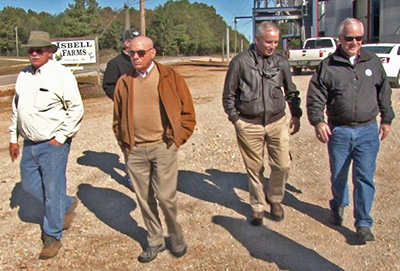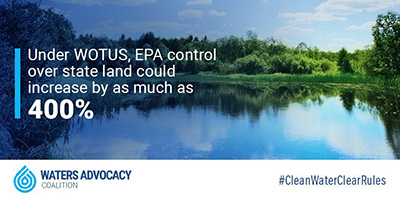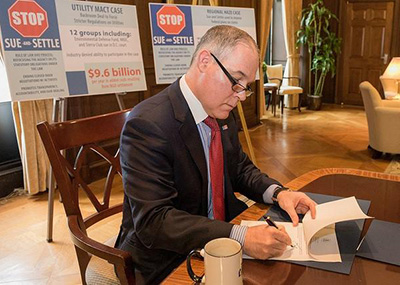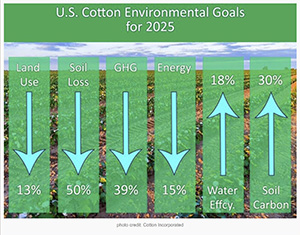Regulatory
Throughout the year, the National Cotton Council conveyed its views on various regulatory matters to EPA and Congress and advocated for sensible regulations and proper legislative oversight. Comments submitted to EPA noted 1) regulations that need to be revised, repealed or replaced such as several pesticide registrations that require a review and 2) more overarching regulations such as “Waters of the U.S.,” Spill Prevention Control and Countermeasures, and Worker Protection Standards (WPS).
Regarding the WPS, the NCC continued to work with EPA after it announced processes to revise 1) some WPS requirements such as minimum age requirements, designated representatives, and application exclusion zones; and 2) the minimum age requirements in the Certification & Training Rule (for pesticide applicators). Late in the year, the NCC reviewed for an opportunity to comment on EPA's notice that it had initiated a rulemaking process to revise the minimum age requirements for that applicators rule. EPA also announced that in 2018, it will review and provide a comment period for certain controversial aspects of WPS.
The NCC and many other agricultural stakeholders supported the "The Reducing Regulatory Burdens Act” (H.R. 953). The legislation, introduced by Representative Bob Gibbs (R-OH), called for removing the duplicative and unnecessary Clean Water Act permit for spraying pesticides anywhere near water that was mandated by a 2009 6th Circuit Court decision. The House Agriculture Committee approved the bill.
Later, the NCC was one of 616 co-signers of a multi-association letter sent to Senators urging them to pass the Regulatory Accountability Act (RAA) which was introduced in the Senate with bipartisan support. The RAA introduction was seen as a significant step forward as it called for modernizing the regulatory process and making it more transparent.
The NCC submitted comments to the U.S. Interior Department which disagreed with the government's designation of the Rusty Patched Bumble Bee (RPBB) to be on the endangered species list. Following the Senate Environment and Public Works Committee's hearing to discuss reforming the Endangered Species Act (ESA), the NCC submitted comments for the record on the issues of registration delays, lack of water in the western states due to ESA restrictions, and the unscientific process used to list the RPBB as endangered. Later, a petition signed by the NCC and other stakeholders was delivered to the Secretary of the Interior and to the acting director of the U.S. Fish & Wildlife Service asking them to delay implementation of the RPBB endangered listing until January 2018.
The NCC and the National Cotton Ginners Association (NCGA), along with eight other state and regional gin associations, filed comments with the U.S. Food and Drug Administration (FDA) on their guidance titled, “Classification of Activities as Harvesting, Packing, Holding, or Manufacturing/Processing for Farms and Facilities.” The document was part of directions for cotton and other industries on how to comply with FDA’s Food Safety Modernization Act’s (FSMA’s) final rule for “Preventive Controls for Animal Food.” The comments argued that treating cottonseed differently from grain was not a correct decision based on risk. The comments also explained that the agency’s argument is not applicable to the cotton ginning industry as the activities in a cotton gin, whether farmer or non-farmer owned, all can be classified within either the harvesting activity or storage of a raw agricultural commodity category.

To help amplify this message, the NCC and the NCGA held a fact-finding tour in Alabama for several senior level FDA officials. This enabled them to see cotton harvesting and ginning firsthand as the Agency continued to address the ginning industry’s concerns with the FSMA’s Animal Feed Rule.
The NCC sent a letter to House Science, Space, and Technology Committee Chairman Lamar Smith (R-TX) in support of two House-passed bills. The Honest and Open New EPA Science Treatment Act of 2017 (H.R. 1430) would prohibit the EPA from proposing, finalizing, or disseminating a covered action unless all scientific and technical information relied on to support such action is the best available science, specifically identified, and publicly available in a manner sufficient for independent analysis and substantial reproduction of research results. The other House-passed regulatory reform bill, the "EPA Science Advisory Board Reform Act of 2017" (H.R. 1431), amended the Environmental Research, Development, and Demonstration Authorization Act of 1978 to revise the: 1) process of selecting Science Advisory Board (SAB) members, 2) guidelines for participation in board advisory activities and 3) terms of office.
When EPA announced its intention to balance SAB representation, the NCC encouraged the agency to review the balance for all Scientific Advisory Panels (SAP) and address the long-term unbalanced representation on scientific panels that often dismisses studies because the members do not have full understanding of particular methodologies or issues related to the studies.
The NCC joined with one coalition on a letter to the Senate Environment and Public Works (EPW) Committee for four individuals nominated to be assistant administrators at EPA: Michael Dourson as assistant administrator of the Office of Chemical Safety and Pollution Prevention, which oversees the Office of Pesticide Programs; Matthew Leopold for EPA assistant administrator, Office of the General Counsel; David Ross for EPA assistant administrator, Office of Water; and William Wehrum for EPA assistant administrator, Office of Air & Radiation. The NCC joined with another pesticide-specific coalition on another letter supporting Dourson and continued to follow the nomination process for these individuals.
Mid-year, the NCC filed comments supporting the Occupational Safety and Health Administration's (OSHA) decision to delay the implementation of “Improve Tracking of Workplace Injuries and Illnesses.” The NCC stated that system for electronically reporting injuries was not available and that the NCC had concerns over some parts of the rule, which was issued in 2016. OSHA proposed to extend the initial submission deadline for 2016 Form 300A data to December 1, 2017, to provide the new administration an opportunity to review the new electronic reporting requirements prior to their implementation and allow affected entities sufficient time to familiarize themselves with the electronic reporting system. Late in the year, OSHA indicated it might move forward with another proposal to address issues and concerns with the reporting requirement brought to their attention by the cotton industry, and the NCC was prepared to seek additional changes to the existing rule.
The NCC was among 147 organizations, associations, chambers of commerce and companies which signed on to a support letter for the Ozone Standards Implementation Act of 2017 (H.R. 806), which passed in the House by a 229-199 vote. The Act's purpose was to "... Provide states the flexibility needed to implement the National Ambient Air Quality Standards for ground-level ozone on an efficient and realistic timeline; Ensure the nation's infrastructure and manufacturing permitting continue while making improvements to air quality ..."
Allen McLaurin, a North Carolina cotton producer and member of EPA's Pesticide Program Dialogue Committee (PPDC), covered issues affecting cotton producers during the PPDC's May meeting. Among those issues were inconsistent and conflicting EPA guidance to growers on resistance management. His comments became part of an official docket on regulatory reform. The NCC followed up with written comments to that docket which also included a discussion of the new Worker Protection Standards, a new rule for the training of pesticide applicators and the proposed risk assessments for neonicotinoids. Don Parker, NCC’s manager, Integrated Pest Management and a member of a PPDC workgroup, discussed a proposed metrics program for measuring the progress of state managed pollinator protection plans.
McLaurin later attended the PPDC’s fall meeting where worker protection, dicamba and chlorpyrifos were among key issues discussed.
WOTUS
The NCC announced it strongly supported EPA’s decision to rescind the 2015 Clean Water Rule, more commonly known as “WOTUS” (Waters of the U.S.). The NCC stated it believed this regulation, which has not been implemented due to court cases, created confusion among the regulated agricultural community as well as other industries. The NCC, which noted that it was ready to provide input to the Agency in the creation of a new rule, also extended appreciation to EPA for asking states to comment on WOTUS and potential fixes -- an action that shows that the Agency was ready to seek input so that the next version of the regulation could be simplified and the roles of the federal and state governments and stakeholders clarified.

The Waters Advocacy Coalition (WAC), of which the NCC is a member, sent to President Trump a letter applauding him for his Executive Order on the WOTUS rule. The Order directed EPA and the U.S. Army Corps of Engineers (Corps) to publish a proposed rule that rescinds or revises the WOTUS rule “as appropriate and consistent with law.” The NCC and other agricultural groups worked closely with the Administration to ensure the rural community had a voice during the Office of Management & Budget's review of EPA's proposal.
After EPA and the Corps published in the July 27 Federal Register their proposed rule, “Definition of ‘Waters of the United States’ - Recodification of Pre-Existing Rules,” the NCC commented in favor of rescinding the definition of WOTUS (from the Obama Administration’s 2015 Clean Water Rule) in the Code of Federal Regulations. The NCC developed a template letter to help its members create individual comments and urged them to file their comments in support of the WOTUS rule repeal and the temporary reinstatement of the previous rule. NCC comments to EPA and the Corps asked them to finalize their proposal to rescind WOTUS.
In a second step that came later in the year, the two agencies pursued notice-and-comment rulemaking in which they conducted a substantive re-evaluation of the definition of WOTUS in a new proposal. The NCC continued working with those agencies in drafting a new, more reasonable rule that would protect the nation’s water resources and allow normal farming practices without threat of legal action against growers.
The WAC filed comments to the Corps’ Regulatory Reform Task Force as part of responding to President Trump’s Executive Order No. 13,777 on regulatory reform. The comments included the WAC’s contention that the Corps’ headquarters needed to assert control over its regional offices in order to ensure consistent implementation of the same regulations. The WAC also suggested that the Corps 1) rescind supplements to the Wetlands Delineation Manual that were being used to find wetlands in agricultural land that did not exhibit all three required wetland characteristics; and 2) revise the definition of the Ordinary High Water Mark that was used in the Waters of the U.S. rule to claim jurisdiction over swales that only sometimes carry rainwater.
Late in the year, the NCC submitted comments to EPA and the Corps in response to those agencies’ last proposal on the 2015 “Waters of the U.S.” (WOTUS) rule – a proposal from August 28, 2017, requesting recommendations for revisions to the WOTUS definition. The comments 1) pointed out problematic areas in the original rule that lacked clarity and/or expanded federal jurisdiction beyond the limits placed by the Clean Water Act, the intent of Congress, and the Supreme Court and 2) suggested these problematic areas be removed or corrected in a new rule.
The NCC also reviewed a November 22, 2017, proposal from EPA and the Corps that sought to amend the effective date of the 2015 rule defining WOTUS. The agencies proposed that the 2015 rule would not go into effect until two years after that action was finalized and published in the Federal Register. Subsequently, the NCC joined with 21 producer interest organizations on comments that noted the addition of a delayed applicability date will have the benefit of reducing potential confusion resulting from an upcoming Supreme Court decision which will decide whether the Sixth Circuit court or the court of appeals has original jurisdiction to review challenges to the 2015 Rule.
In other regulatory matters, the NCC:
- joined with 28 other organizations on a letter to the Senate requesting that the Senate confirm Oklahoma Attorney General Scott Pruitt as EPA administrator and later publicly announced that it was pleased with the Senate’s confirmation of Pruitt.
- in conjunction with several agricultural coalitions, compiled and submitted to EPA a list of regulations it believed needed to be reformed, repealed or replaced. The list was in response to President Trump's Executive Order (Enforcing the Regulatory Reform Agenda) calling for public comments which were to be reviewed by a new EPA Task Force created under the Order.
- was included on a letter to the Senate Committee on Homeland Security and Governmental Affairs asking that panel to support the Regulatory Accountability Act (S. 951) stating the bill would add transparency, sound science, robust cost-benefit analysis and stakeholder engagement to the creation of regulations for agriculture and other industries.
- filed comments supporting EPA’s published proposal to extend the effective date of the Pesticide Applicator Certification and Training rule from May 22, 2017, until May 22, 2018. EPA agreed to the extension.
Crop Protection Product Support
Throughout 2017, the NCC continued to work with others in the agricultural community to ensure EPA relied on credible scientific data and required all studies be subject to the same requirements of product registrants. The NCC and agricultural groups worked to build support for the reauthorization of the Pesticide Registration Improvement Act (PRIA), which establishes fees for registration and re-registration of pesticides as well as many other actions authorized under the Federal Insecticide, Fungicide & Rodenticide Act (FIFRA).
The NCC sought a fair and scientifically sound process on chlorpyrifos and all related organophosphates. That included being a signatory, along with 34 other agricultural stakeholders, on a letter to then EPA Administrator Gina McCarthy decrying the Agency’s action regarding chlorpyrifos. Also, in a drive to save the varied uses of chlorpyrifos, 2,300 businesses and organizations – including 187 from the cotton industry – signed on to a petition. As a member of the Pesticide Policy Coalition, the NCC was part of that group’s comments to the public docket in support of chlorpyrifos.

A group of 43 agricultural stakeholders, including the NCC and the California Cotton Ginners and Growers Association, sent a letter to new EPA Administrator Pruitt asking him to “retain the current crop tolerances and availability of use of the chlorpyrifos-containing products we need.”
After the EPA released an order denying in full a petition filed by the Pesticide Action Network North America and the Natural Resources Defense Council requesting that EPA revoke all tolerances for chlorpyrifos, the NCC issued a release noting that 1) three separate FIFRA Scientific Advisory Panels (SAPs) had cautioned EPA against using the outcomes from Columbia Center for Children’s Environmental Health researchers and 2) at all three SAPs convened on the issue, the panels questioned EPA’s shift to the use of certain epidemiological study outcomes rather than the standard use of toxicological data in human health risk assessments.
In mid-year, the 9th Circuit Court of Appeals issued an order denying the petitioners' (Pesticide Action Network North America and Natural Resources Defense Council) motion for further mandamus relief in the chlorpyrifos proceedings. The decision was in response to the latest lawsuit by activist groups that sued EPA when the Agency denied their petition to outright revoke all tolerances of the pesticide instead of moving the product through the normal registration-review process.
Late in the year, the NCC joined other agricultural groups on a letter to President Trump thanking his Administration for continuing the normal scientific process for chlorpyrifos. The letter commended the Administration for striking a balance between maintaining the pesticide and continuing the ongoing scientific analyses as required by law.
EPA's ongoing review of pyrethroids was monitored by the NCC which filed comments to EPA's docket citing the long history of those insecticides in integrated pest management programs for cotton as well as their continued use in resistance management. The NCC also warned that the loss of this chemistry would result in fewer modes of action against pests and perhaps lead to increased resistance.
The NCC commended EPA after it posted the new label for Enlist Duo enabling the herbicide to be used on Enlist cotton in all cotton growing states with the exception of California for the 2017 season. Enlist Duo, which is a combination of glyphosate and 2,4-D, originally was approved by EPA in October 2014; however, the agency withdrew its registration after the existence of new data came to light.
The NCC filed six sets of comments on seven pesticides, all of which had a July 24, 2017, deadline for public comment established by EPA. The comments were for aldicarb, ethephon, and methoxyfenozide where the NCC pointed out issues with EPA’s analyses of the pesticides. The other three sets of comments were filed for the neonicotinoids clothianidin, imidacloprid, thiamethoxam and dinotefuran. The imidacloprid comments primarily addressed concerns with the water models that NCC believed EPA uses incorrectly to assess aquatic risk. Comments on the other three neonicotinoids concentrated on errors in EPA’s study of risks to bees and on providing EPA with the benefits that these products provide for efficient cotton production. The NCC monitored EPA’s review process and worked to ensure these products’ continued availability.
Late in the year, the NCC provided comments after EPA announced the availability of its draft ecological non-pollinator risk assessment for the registration review of imidacloprid, along with draft human health and non-pollinator ecological risk assessments for the registration review of clothianidin, thiamethoxam, and dinotefuran. The notice also announced the availability of benefits assessments of neonicotinoid insecticide use in cotton.
EPA announced an agreement with Monsanto, BASF and DuPont on measures to further minimize damage to neighboring crops from the use of dicamba formulations used to control weeds in genetically modified cotton and soybeans. New requirements for “over the top” use of dicamba (application to growing plants) would allow producers to make informed choices for seed purchases for the 2018 growing season. The NCC continued to work closely with EPA on the goal of keeping dicamba labeled for use beyond the 2018 growing season.
The NCC submitted separate comments regarding EPA’s preliminary ecological risk assessments for oxamyl and prometryn. The comments explained that both products previously have been registered as long-term crop protection products and provide a unique mode of action for multiple resistance management scenarios.
Biotechnology
Throughout the year, the NCC worked with Congress and the Administration to ensure innovative biotechnology products are approved in a timely manner and are available to producers.
The NCC provided comments after the White House released its 2017 Update to the Coordinated Framework for the Regulation of Biotechnology. That Update was accompanied by the National Strategy for Modernizing the Regulatory System for Biotechnology Products -- to offer the public a complete picture of the regulatory structure that provides oversight for all modern biotechnology products.
The NCC was actively engaged with the USDA’s Animal and Plant Health Inspection Service (APHIS) prior to the agency's pre-publication of a proposed rule to revise its regulations regarding the importation, interstate movement and environmental release of certain genetically engineered organisms, 7 CFR part 340 (also known as Part 340). The NCC commended the Agency for its work on the regulations and that the proposal recognized plant breeders’ long track record of safety and quality. Later, the NCC submitted comments on proposed revisions to Part 340. The NCC believed the proposed changes would have a significant negative impact on agricultural innovation, particularly for small companies and universities focused on developing products for a specific regional need or environmental use. The NCC, along with other agricultural organizations, also continued to work with the Administration and Congress to ensure any rule put forward is science-based and does not prohibit producers from accessing necessary tools and technology for efficiently producing crops.
Late in the year, the NCC submitted comments to APHIS in full support of a petition submitted by Bayer CropScience LP, which was seeking a nonregulated status for cotton (event GHB811) that had been genetically engineered for dual resistance to the herbicides glyphosate and isoxaflutole, an HPPD-inhibitor. Bayer’s plan was to commercialize GHB811 in a breeding stack designed to provide U.S. cotton producers with a new seed innovation providing tolerance to three herbicides and containing three insect resistance proteins.
Other NCC comments addressed the FDA’s notice for a request for comments on “Genome Editing in New Plant Varieties Used for Foods.” Those comments emphasized the need for a regulatory process on genome edited products that is clear and predictable for researchers and industry, and that also is science-based. In its comments, the NCC applauded the Administration’s efforts to update government regulations to support new technologies and innovation, and pledged the industry’s cooperation as the process continued.
The NCC, along with other members of the Coalition for Safe and Affordable Food, submitted a joint response to USDA’s Agricultural Marketing Service’s query regarding the development of a rule to implement the National Bioengineered Food Disclosure Law. The questions covered a variety of topics including how certain products should be defined as well as what products should be excluded from the rule.
Cotton Flow/Packaging

The NCC was active on several fronts throughout the year addressing issues affecting the timely movement of baled cotton fiber to domestic and foreign customers, the acceptance of materials used to package U. S. cotton fiber, and the development of new, innovative packaging materials and techniques.
USDA notified the NCC that the revised Joint Cotton Industry Bale Packaging Committee (JCIBPC) Specifications for Cotton Bale Packaging Materials for packaging 2017-crop cotton were approved for Commodity Credit Corporation (CCC) loan program purposes.
The Specifications, which were posted on the NCC's website at www.cotton.org/tech/bale/specs/, called for: 1) removing all references to flat bales and modified flat bales from the 2017 edition of the cotton bale packaging specifications; 2) requiring the inclusion of correct bag/tie codes on electronic warehouse receipts, and 3) NCC staff to report on the views of the raw cotton segment and packaging suppliers on the time that would reasonably be needed to make a transition away from the use of wire strapping.
Late in the year, NCC staff distributed to the JCIBPC a report on the raw cotton segments’ and packaging suppliers’ input regarding the use of wire ties. Their views were obtained from a NCC survey.
The JCIBPC’s Executive Committee agreed to forward to the NCC’s Permanent Bale Identification (PBI) Task Force a request by some JCIBPC members that would call for removing from the PBI tag specifications the requirement that “A” and “B” coupons be included on tags. However, even if this request was accepted by the Task Force, gins and warehouses still would have the option of including the coupons on their bale tags.
JCIBPC approvals were granted for continued testing of two light-weight cotton bale bags, a compatibility test program for third party polyethylene terephthalate (PET) strap on patented z-weld friction technology® systems, and a fifth-year test program for a new category of woven PET bags (along with that bag's automated bagging system). Except for the two light-weight cotton bag test programs that were restricted to the Far West region for exported bales, “JCIBPC determinations” were granted for the other two test programs. In accordance with Intercontinental Exchange (ICE) Cotton No. 2® rules on bands and bagging, an explicit determination from the JCIBPC is necessary for bales in experimental test programs to meet a key delivery requirement for bales being delivered against No. 2® cotton contracts. No bales in the first year of an approved JCIBPC test program are deemed deliverable against the contract.
The JCIBPC Executive Committee later approved a first year test program of 100,000 bales at two gins for DuBose Strapping Inc.’s CFS 1955 PET Strapping System. Once a system like this completes at least two years in successful test programs, it could be eligible to have its name added to the JCIBPC’s list of approved PET strapping systems.
Warehousers were reminded of their responsibility to preserve the integrity of bale bags and ties prior to shipping. Specifically, warehousers were asked to repair or replace torn bale packaging and replace broken or missing bale ties. This reminder was a result of a recent uptick in complaints to the NCC from both domestic and foreign textile manufacturers regarding some U.S. bales’ the appearance.
The NCC reminded warehousers with USDA CCC Cotton Storage Agreements that bag and tie codes were required elements of warehouse receipts after the JCIBPC adopted that recommendation at its 2017 annual meeting. As the 2017 harvest, ginning and storage got underway, the NCC reminded industry members about proper bale identification, including adherence to multiple requirements. Gins were reminded that according to the Guide for Cotton Bale Standards, a requirement for a “Grade A” bale is the placement of PBI tags on, not under, bale bags.
Ginners and warehouses also were reminded not only of the importance of properly tagging bales but making sure the USDA Agricultural Marketing Service (AMS) classing coupons always match the PBI tags on bales. NCC President/CEO Gary Adams’ memo to ginners alerted them to increased incidences of mismatched PBI tags and sample coupons with the 2017 crop compared to the 2016 crop. The memo urged gins to remind their licensed samplers that they are responsible for the actions of the employees under their supervision and emphasized that correcting AMS records associated with mismatches is time consuming and expensive.
The Cotton Flow Working Group was established as NCC Cotton Flow Committee subcommittee to investigate other countries’ flow practices and industry procedures that allow the market to reward prompt service and penalize those practices that impede flow. That Group met twice and developed several recommendations for consideration as NCC policies. The Group anticipates 2018 work on more recommendations designed to enhance the efficient movement of baled cotton fiber through the marketing chain.
Late in the year, the Federal Motor Carrier Safety Administration (FMCSA) granted a limited 90-day waiver from the federal hours-of-service regulations pertaining to electronic logging devices for the transportation of agricultural commodities as defined in the Federal Motor Carrier Safety Regulations. The waiver was to expire on March 18, 2018. The NCC also reviewed for an opportunity to comment on FMCSA's regulatory guidance to clarify the applicability of the ‘‘Agricultural Commodity’’ exception to the ‘‘Hours of Service of Drivers’’ regulations. The regulatory guidance, announced late in 2017 and which would expire five years after being finalized, was being proposed to ensure consistent understanding and application of the exception by motor carriers and state officials enforcing hours of service rules.
Research/Education
The NCC worked with Congress and others in agriculture to ensure funding availability for various agricultural research programs.
In collaboration with the Cotton Foundation, the NCC held an Educational Outreach Program on the issue of bee health and neonicotinoids. EPA participants from the agency’s pesticide office discussed neonicotinoid draft risk assessments with state university entomologists, cotton producers and their partner-beekeepers. University scientists presented several recent research studies showing the value of agriculture to bee health, the value of crop protection products to crops, the lack of evidence that neonicotinoids are affecting bee hives, and the benefits of reducing foliar pesticide uses that may lead to other pest infestation issues.
The NCC continued an initiative advocated for and begun in 2016 by the NCC's Quality Task Force that asked domestic and foreign textile manufacturers to submit photographs showing contaminated lint. The photographs had been sought by the NCC at the request of some ginners wanting images of seed cotton, lint and baled cotton contaminated from plastics. The photograph solicitation was part of the NCC’s “Keep it Clean” initiative which is keeping industry members informed of contamination incidences and threats as well as providing steps for eliminating contaminating materials.
More than 1,000 attended the 2017 Beltwide Cotton Conferences in Dallas. The forum focused on research of new and existing products and technologies and the transfer of these to producers through consultants, Extension, allied industry and others directly involved in assisting producers with crop production and marketing decisions. Dr. Peng Chee, a professor of Cotton Molecular Genetics/Breeding at the University of Georgia’s Coastal Plain Experiment Station in Tifton, Ga., received the 2016 Cotton Genetics Research Award.
Sustainability

In compliance with a NCC-adopted sustainability resolution, the NCC created a COTTON USA Sustainability Task Force which set goals to build upon the strong environmental gains already achieved over the past 30 years. Task Force Chairman Ted Schneider announced that among specific goals being pursued by 2025 are: reducing: 1) the amount of land needed to produce a pound of cotton fiber by 13 percent; 2) soil loss by 50 percent, in balance with new soil formation; 3) energy to produce seed cotton and ginned lint by 15 percent; and 4) greenhouse gas emissions by 39 percent; and increasing: 1) water use efficiency (more fiber per gallon) by 18 percent; and 2) soil carbon in fields by 30 percent.
The NCC continued its support of the Cotton LEADS™ program. Among those joining the program’s 470-plus partners were L.L. Bean, Hugo Boss, Walmart and Gap Inc., which announced that its Gap brand was committed to sourcing 100 percent of its cotton from more sustainable sources by 2021, while its Athleta brand aimed to use 80 percent sustainable fibers in its apparel by 2020.
Among other research and education activities, the NCC:
- cooperated with the National Cotton Ginners Association (NCGA) on the three 2017 Ginner Schools – the Western Ginners School in Las Cruces, N.M.; the Stoneville Ginners School in Stoneville, Miss.; and the Southwest Ginners School in Lubbock.
- partnered with the American Seed Trade Association (ASTA) which updated outreach materials for producers on stewardship for treated seeds – including a new seed treatment stewardship guide at http://seed-treatment-guide.com/.

